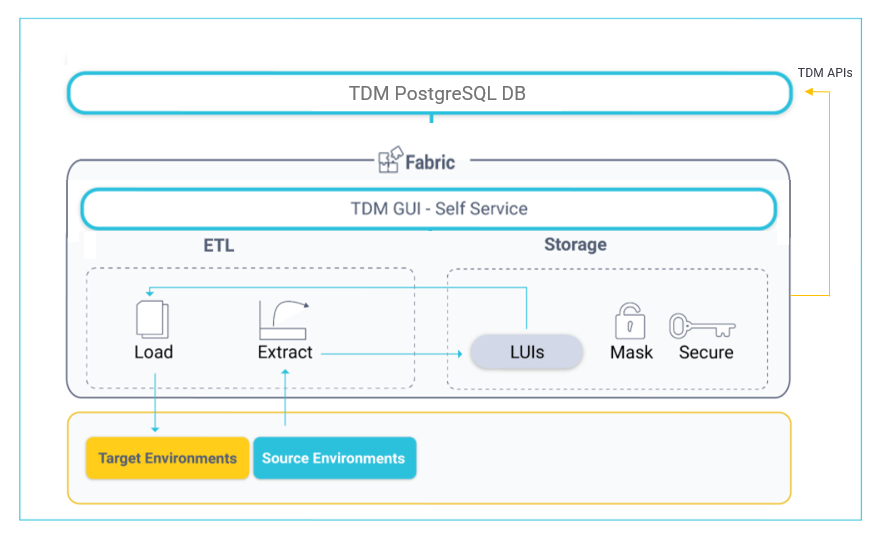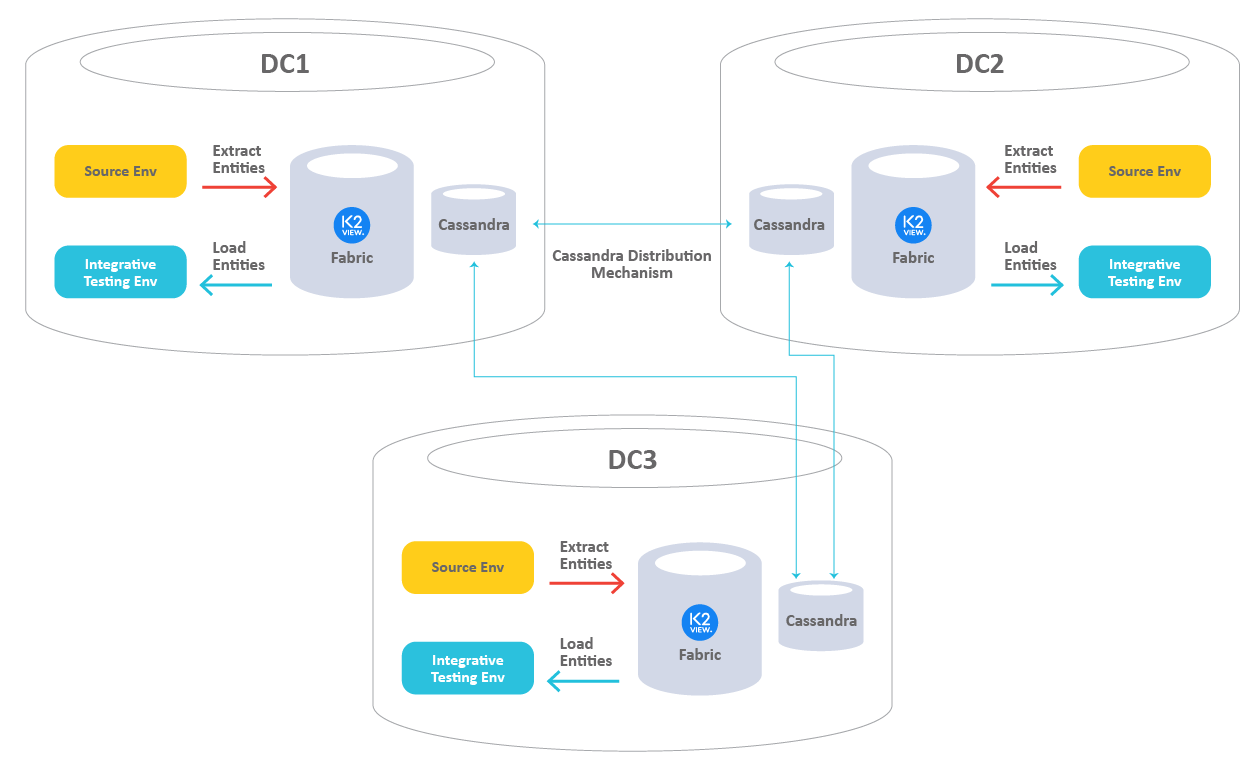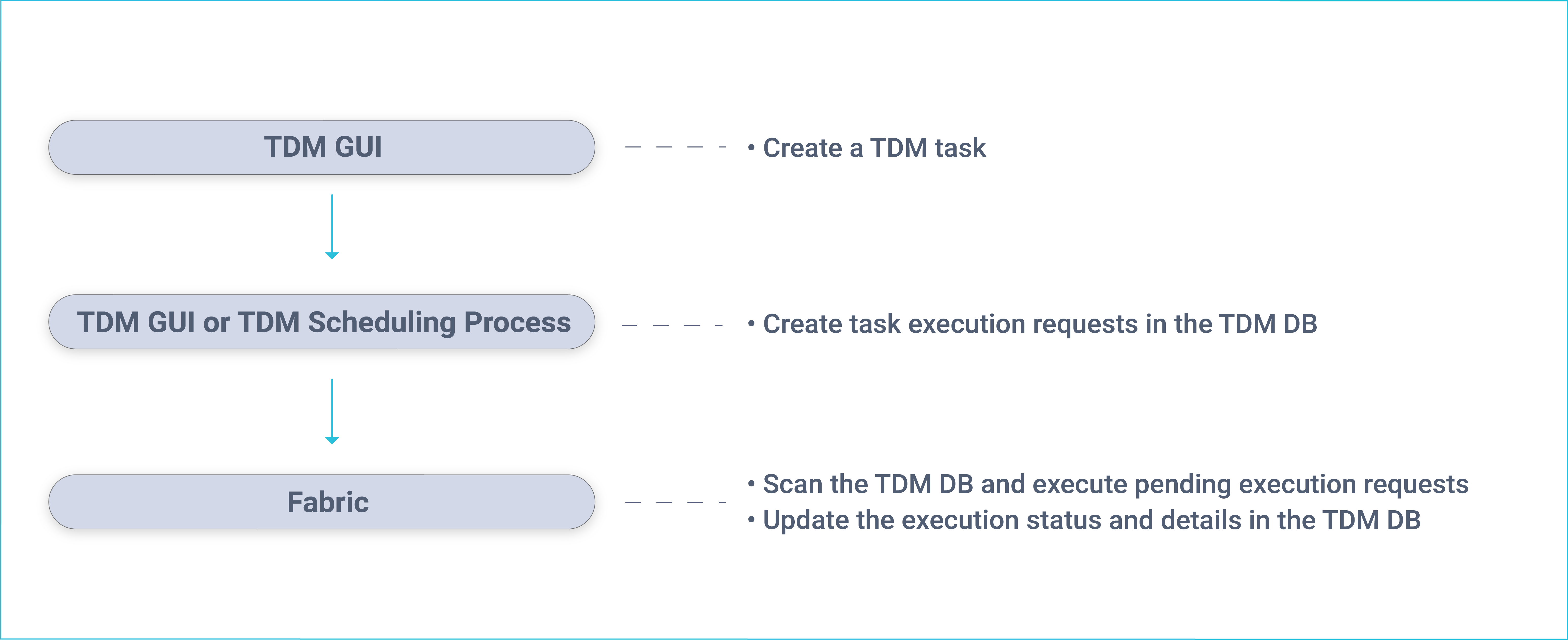TDM Architecture
TDM Components
The K2View TDM has the following components:
- TDM GUI (self-service).
- TDM DB.
- Fabric.

TDM GUI
The TDM web application is pre-integrated in Fabric Web Framework and offers self-service implementation of the following activities:
- TDM definitions, setting TDM Business Entities, environments, roles and permissions.
- Creation and execution of TDM tasks that provide a selected subset of entities or Reference tables to the selected environment.
TDM DB
TDM settings and tasks are kept in the TDM PostgreSQL DB. Both TDM layers, the backend and frontend, connect to the TDM DB to get or update TDM settings or tasks.
Fabric
Fabric acts as a staging DB for the provisioned entities and as an ETL layer for extracting data from data sources and loading it to the target environment.
In addition, the TDM back-end APIs and processes are defined and executed in Fabric. The TDM back-end APIs and processes are included in the TDM library.
Fabric as a Staging Repository
When running a TDM task, data from the selected entities is stored and synchronized in Fabric according to its LUs definitions. Fabric creates and maintains a separate MicroDB for each entity (LUI). This has several advantages:
Convenience - Encapsulating the data of a business entity into one place so that it can be queried by consumers (many business entities have data residing in multiple data sources).
Security - MicroDB encryption (each MicroDB is encrypted separately) and field-level encryption provide more robust security.
Masking capabilities - masking sensitive data when storing entities.
Flexibility - Flexible sync policies based on business needs, including:
- Extracting an entity's data from source environments and storing it in Fabric in advance so that requests for loading it into target environments can be implemented without accessing source systems.
- Synchronizing data from source systems in order to get the most up-to-date data on entities when required.
- Version control - TDM enables creating and executing Data Versioning tasks in order to maintain various versions (snapshots) of each selected list of entities. Each version is kept as a separate LUI. For example, saving a version of a customer's list every 2 hours in order to back up the data during functional tests.
Reference Tables
Reference or Operational tables that are copied as they are, can be extracted from the source environment and saved into Cassandra under the k2view_tdm keyspace. These tables can be later loaded into selected target environments.
Click here for more information about TDM Reference Handling.
Fabric ETL Capabilities
- Fabric ETL capabilities are used to extract data from data sources and load it into selected target environments.
- Broadway is a Fabric module used to design data movement, its transformation and the orchestration of business flows. Featuring a powerful user interface for creating and debugging business and data flows, Broadway also provides a high-performance execution engine activated by Fabric. Broadway supports a wide range of data sources as well as data transformation logic such as:
- Replacing sequences in order to prevent a collision with the target environment.
- Masking sensitive data before loading it to the target environment.
TDM - Multi DCs Architecture
An organization's systems and environments can be located in different geographic locations. This topography requires data transmission between distant locations.
Example:
- The CRM and Billing Production systems are located in NY (DC1).
- The Ordering and Ticketing Production systems are located in TX (DC2).
- The testing environments are located in NY, TX, and CA (DC3).
- The testing environments in CA need to get the CRM and Billing data from NY, and the Ordering and Ticketing data from TX.
One of the main challenges when running a data transmission over the network is the performance of the data transmission. Getting data from a distant location may be time-consuming.
K2view TDM architecture ensures efficient and quick data transmission between different locations. The following diagram is an example of the TDM architecture in a multi-DC topography:

- Each Data Center (DC) has its own Fabric and Cassandra nodes.
- The data is extracted from the source locally on each DC and is stored in Fabric. Fabric uses Cassandra as a storage layer for the entities.
- The data is distributed automatically by Cassandra between DCs.
- The data load is executed in the target’s DC and accesses the entities in the local Fabric nodes. Note that if the entity needs to be synced from the source by the load task, the sync (extract) runs on the database of the source using a remote GET LUI command.
TDM - Data Provisioning Flow
In general, data provisioning can be divided into 2 main sections:
- Data provisioning requests are created by a TDM task. The TDM task is created by a user via the TDM GUI and is saved in the TDM DB. The TDM task specifies the what and when details of the data request:
- What - a Business Entity to be provisioned such as customer, employee, order, product, source and target environments, subset of entities and general request parameters like Sync mode.
- When - when a task has to be executed. Execute either by a request or by setting scheduling parameters for a periodical task execution.
- Task execution - a task can be executed manually via the TDM GUI or periodically via the TDM Scheduler process based on predefined scheduling parameters.
The following diagram displays the TDM task creation and execution processes:

Fabric runs a batch process that executes pending execution requests:
- Extract tasks - selected entities are extracted from the source environment and migrated into Fabric. The batch process initiates a Sync of the selected entities into Fabric.
- Load task - the batch process initiates a Broadway flow, which retrieves the LUIs from Fabric, transforms the data if needed, and loads the entities to the selected target environment.
- Delete task - the batch process initiates a Broadway flow, which retrieves the LUIs from Fabric - in order to get the target keys for delete - and deletes the entities from the selected target environment.
- Reserve task - the batch process initiates a Broadway flow, which marks the entities as reserved entities in the TDM DB.
A dedicated Fabric process checks for completed executions and updates the TDM DB accordingly on the execution's status and statistics. Additionally, Fabric receives information and statistics about executed tasks and saves them in the Fabric TDM LU.
TDM Architecture
TDM Components
The K2View TDM has the following components:
- TDM GUI (self-service).
- TDM DB.
- Fabric.

TDM GUI
The TDM web application is pre-integrated in Fabric Web Framework and offers self-service implementation of the following activities:
- TDM definitions, setting TDM Business Entities, environments, roles and permissions.
- Creation and execution of TDM tasks that provide a selected subset of entities or Reference tables to the selected environment.
TDM DB
TDM settings and tasks are kept in the TDM PostgreSQL DB. Both TDM layers, the backend and frontend, connect to the TDM DB to get or update TDM settings or tasks.
Fabric
Fabric acts as a staging DB for the provisioned entities and as an ETL layer for extracting data from data sources and loading it to the target environment.
In addition, the TDM back-end APIs and processes are defined and executed in Fabric. The TDM back-end APIs and processes are included in the TDM library.
Fabric as a Staging Repository
When running a TDM task, data from the selected entities is stored and synchronized in Fabric according to its LUs definitions. Fabric creates and maintains a separate MicroDB for each entity (LUI). This has several advantages:
Convenience - Encapsulating the data of a business entity into one place so that it can be queried by consumers (many business entities have data residing in multiple data sources).
Security - MicroDB encryption (each MicroDB is encrypted separately) and field-level encryption provide more robust security.
Masking capabilities - masking sensitive data when storing entities.
Flexibility - Flexible sync policies based on business needs, including:
- Extracting an entity's data from source environments and storing it in Fabric in advance so that requests for loading it into target environments can be implemented without accessing source systems.
- Synchronizing data from source systems in order to get the most up-to-date data on entities when required.
- Version control - TDM enables creating and executing Data Versioning tasks in order to maintain various versions (snapshots) of each selected list of entities. Each version is kept as a separate LUI. For example, saving a version of a customer's list every 2 hours in order to back up the data during functional tests.
Reference Tables
Reference or Operational tables that are copied as they are, can be extracted from the source environment and saved into Cassandra under the k2view_tdm keyspace. These tables can be later loaded into selected target environments.
Click here for more information about TDM Reference Handling.
Fabric ETL Capabilities
- Fabric ETL capabilities are used to extract data from data sources and load it into selected target environments.
- Broadway is a Fabric module used to design data movement, its transformation and the orchestration of business flows. Featuring a powerful user interface for creating and debugging business and data flows, Broadway also provides a high-performance execution engine activated by Fabric. Broadway supports a wide range of data sources as well as data transformation logic such as:
- Replacing sequences in order to prevent a collision with the target environment.
- Masking sensitive data before loading it to the target environment.
TDM - Multi DCs Architecture
An organization's systems and environments can be located in different geographic locations. This topography requires data transmission between distant locations.
Example:
- The CRM and Billing Production systems are located in NY (DC1).
- The Ordering and Ticketing Production systems are located in TX (DC2).
- The testing environments are located in NY, TX, and CA (DC3).
- The testing environments in CA need to get the CRM and Billing data from NY, and the Ordering and Ticketing data from TX.
One of the main challenges when running a data transmission over the network is the performance of the data transmission. Getting data from a distant location may be time-consuming.
K2view TDM architecture ensures efficient and quick data transmission between different locations. The following diagram is an example of the TDM architecture in a multi-DC topography:

- Each Data Center (DC) has its own Fabric and Cassandra nodes.
- The data is extracted from the source locally on each DC and is stored in Fabric. Fabric uses Cassandra as a storage layer for the entities.
- The data is distributed automatically by Cassandra between DCs.
- The data load is executed in the target’s DC and accesses the entities in the local Fabric nodes. Note that if the entity needs to be synced from the source by the load task, the sync (extract) runs on the database of the source using a remote GET LUI command.
TDM - Data Provisioning Flow
In general, data provisioning can be divided into 2 main sections:
- Data provisioning requests are created by a TDM task. The TDM task is created by a user via the TDM GUI and is saved in the TDM DB. The TDM task specifies the what and when details of the data request:
- What - a Business Entity to be provisioned such as customer, employee, order, product, source and target environments, subset of entities and general request parameters like Sync mode.
- When - when a task has to be executed. Execute either by a request or by setting scheduling parameters for a periodical task execution.
- Task execution - a task can be executed manually via the TDM GUI or periodically via the TDM Scheduler process based on predefined scheduling parameters.
The following diagram displays the TDM task creation and execution processes:

Fabric runs a batch process that executes pending execution requests:
- Extract tasks - selected entities are extracted from the source environment and migrated into Fabric. The batch process initiates a Sync of the selected entities into Fabric.
- Load task - the batch process initiates a Broadway flow, which retrieves the LUIs from Fabric, transforms the data if needed, and loads the entities to the selected target environment.
- Delete task - the batch process initiates a Broadway flow, which retrieves the LUIs from Fabric - in order to get the target keys for delete - and deletes the entities from the selected target environment.
- Reserve task - the batch process initiates a Broadway flow, which marks the entities as reserved entities in the TDM DB.
A dedicated Fabric process checks for completed executions and updates the TDM DB accordingly on the execution's status and statistics. Additionally, Fabric receives information and statistics about executed tasks and saves them in the Fabric TDM LU.



